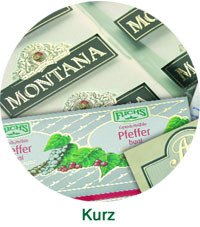Foil Stamping: Let it Shine
- Published: March 31, 2005, By Debbie Donberg, Associate Managing Editor
Product Focus
When Neil Young released "Let It Shine" in 1976, he sure wasn’t thinking about products on store shelves. Yet over these past few decades, in a sense that could have become the anthem in packaging.
High-end packages such as cosmetics and wine labels have been shining for years, but Sam Mc- Elree, product manager, graphics, at Kurz (kurzusa.com), says, "The trend we see the past few years is products decorated with stamping foils appearing in all stores, not just at cosmetics counters, but in supermarkets, discount stores, etc. I never thought I’d see it on gum packs! This is all to grab the customer’s attention as he or she walks the aisle. If the customer picks it up, they tend to put it in the basket. You want to differentiate yourself on the shelf, and foils can do that."
Stewart Glazer, VP sales and marketing, Crown Roll Leaf (crownrollleaf.com), agrees. "The need to separate yourself on the shelf keeps growing, because there are so many more products. DVDs are huge, and we see continuing interest from all end-users, including ancillary packaging."
Foil stamping also is playing a big role in dealing with two areas of security: tampering and counterfeiting.
Glazer says of some tamper-evident labels, "When you touch them, they tear apart and can’t be replaced on the package. We’re also being asked for more anti-counterfeiting holograms, etc., so packages can’t be duplicated by counterfeiters."
Today’s options in a holographic stamping product include both overt and covert features, says McElree. "Through education, consumers can learn how to recognize a genuine product by way of the overt features. Covert features allow the product manufacturer to go into a store and ‘read’ the outside with a special IR device or high-powered magnifying glass. Only the manufacturer can perform this audit to foil counterfeiting."
How secure is secure when it comes to counterfeiting? It depends what level the customer wants, McElree says. "Some things can’t be readily knocked off. Bank notes usually have the highest level. Toothpaste needs some security, but not as much."
On cold foil stamping versus hot, McElree says, "We see applications in both areas, but more people are asking about cold process lately. That’s because the adhesive technology has greatly improved over last few years, making it more of a viable process. It’s easier to do a cold foil than invest in a hot foil unit, and since heat is not involved, you can generally run at greater speeds. But you can’t emboss with cold foil, so there’ll always be a need for hot foil."
Both McElree and Glazer acknowledge the changes in materials to accommodate foil stamping equipment that has gotten faster.
And speaking of speed, Peter Witzig, SP product line manager at Bobst (bobstgroup.com), does so from the equipment point of view. "Everyone wants more speed, but in foil stamping speed is dictated by the material, the layout, the appearance of the final product," he says. "More efficient layouts can improve speeds. We work with customers, at our machine set-up seminars, for example, to educate them to improve layout for runnability."
Witzig has seen materials change for faster machines, with suppliers introducing quick-release foils. In addition to speed, Witzig reports the greatest changes in foil stamping equipment have been in the areas of reduced makeready and foil savings, meaning you can use less foil than you used to for the same job. "We do that by improved electronic functions on the machines as well as software to calculate the foil more efficiently."
The most common request from his customers right now, Witzig adds, is to reduce set-up and changeover times.
Witzig agrees with Sam McElree that foil stamping is getting into more everyday products, but in five or ten years, he sees it exploding into food packaging. "Once you get into the stream of food packaging, it will really take off. And it may require different machines because of the sheer volume, so we’ll see bigger machines, for example."
So it’s shelf appeal and security that are driving foil stamping. And it looks like there’s no end in sight, according to Crown’s Stewart Glazer. "We’ve been asked to create more new patterns in the last year than in the last five years, and that has to do with both security and shelf appeal."

For this and other foil stamping new products, see our CMM New Product Digest.
Restrictions of time and space limit the number of companies, products, and trends that we can discuss in these reports. For additional information, see PFFC’s features and departments each month, consult the June Buyers Guide, and search our online archives.













